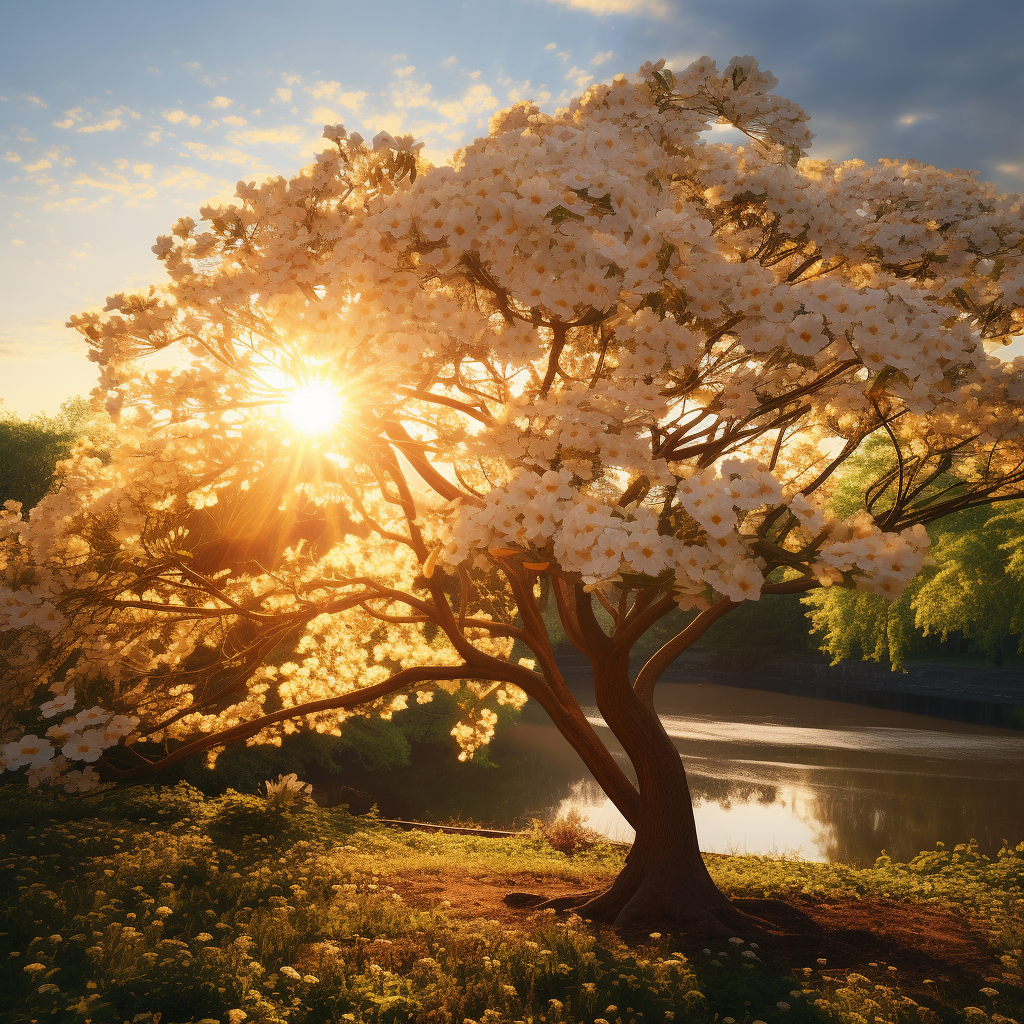
Introduction
There’s something incredibly captivating about white flowering trees. Every spring, these trees burst into life, their branches heavy with stunning white blooms that seem to glow in the sunlight. Not only do these trees add an unmatched aesthetic appeal to any lawn or garden, but they also play a crucial role in supporting our local ecosystems. From providing shade and beauty to supporting pollinator and bird populations, white flowering trees are a smart investment on many levels.
But what exactly are white flowering trees? And why are they so important? In this comprehensive guide, we’ll dive deep into the world of ‘white flowering trees’, exploring their importance, the factors to consider when choosing one, and some of the best varieties to plant in your lawn or garden. So, if you’re ready to transform your outdoor space into a white flowering paradise, keep reading.
Factors to Consider When Choosing a White Flowering Tree
Understanding USDA Hardiness Zones
When choosing a white flowering tree for your lawn or garden, one of the first things you need to consider is whether it can survive winters in your USDA Hardiness zone. The United States Department of Agriculture (USDA) has divided North America into 11 separate zones, each representing a different climate. Each tree has a specific zone or range of zones where it can grow and thrive. By knowing your zone, you can ensure that the tree you choose is well-suited to your local climate.
Sunlight Requirements of Flowering Trees
Most flowering trees require full sun, which is considered 6 or more hours of direct sunlight per day. While some trees can tolerate partial shade, others need ample sunlight to produce their beautiful blooms. Therefore, when choosing a tree, it’s essential to consider the amount of sunlight your chosen planting spot receives daily.
Considering a Tree’s Mature Size
Another crucial factor to consider is the tree’s mature size. It might not look like much now in its gallon-sized container, but don’t be fooled. These trees can grow significantly, and you don’t want to plant it too near your house or under overhead wires. Always consider the tree’s mature height and spread to avoid creating a maintenance nightmare that will require intensive pruning or even removal of the tree a few years down the road.
In the following sections, we’ll delve into the specifics of how to care for your white flowering tree, as well as some varieties you might want to avoid. We’ll also introduce you to our top picks for the best white flowering trees for your lawn or garden. So, stay tuned!
The Importance of Proper Tree Care

Watering Your New Tree
One of the most important steps in establishing a new tree is watering it properly. When you first plant your tree, it’s essential to water it deeply. This initial deep watering helps to settle the soil around the tree’s roots and ensures that water reaches the entire root system.
After this, regular watering during the first growing season is crucial to help establish a strong root system. Remember, a well-established root system is the foundation of a healthy, thriving tree. The frequency of watering will depend on your local climate and the specific needs of the tree, but as a general rule, it’s better to water deeply and less frequently than to water lightly and often.
In the following sections, we’ll discuss some white flowering trees you might want to avoid and give you a detailed list of the top white flowering trees to consider for your lawn or garden. So, let’s continue our journey into the world of white flowering trees.
White Flowering Trees to Avoid
The Case of the Bradford Pear
While there are many wonderful white flowering trees to consider for your lawn or garden, there’s one that you might want to avoid: the Bradford pear (Pyrus calleryana). Once a favorite of developers, this ornamental tree was planted everywhere until its weaknesses became apparent.
Firstly, the trees have flowers that emit a rather unpleasant odor. Some say they smell like rotting fish or cat urine, which is not something you want wafting through your front yard. Secondly, they have weak wood, which tends to split down the middle. This can be dangerous as well as unsightly, especially during stormy weather when branches can easily break off.
To top it off, the Bradford pear is actually considered an invasive species in some parts of the country. This means that it can spread aggressively, outcompeting native plants and disrupting local ecosystems.
So, while the Bradford pear might be attractive at first glance, it’s worth considering these factors before deciding to plant one in your garden.
In the next section, we’ll move on to more promising options, exploring our top picks for the best white flowering trees for your lawn or garden. Stay tuned!
Top White Flowering Trees for Your Lawn or Garden
In this section, we’ll introduce you to our top picks for the best white flowering trees to consider for your lawn or garden. Each of these trees has its own unique charm and characteristics, and all of them can add a touch of elegance and beauty to your outdoor space.
1. Kousa Dogwood (Cornus kousa)
The Kousa Dogwood is more than just an inspiration for punch; these trees offer a ton of curb appeal throughout the year. White springtime blooms are followed by red berries and burgundy fall foliage. The horizontal branching and unique vase-like shape of this type of dogwood are especially appealing qualities. It’s one of the few flowering trees that likes part shade, though it can take full sun in cooler climates. It grows 15 to 25 feet tall and 15 feet wide and is suitable for USDA Hardiness zones 5 to 8.
2. Crab Apple (Malus)
Crab apple trees are available with pink or white blooms. The masses of white springtime flowers are followed by glossy red berries, which the birds love. Some varieties also have attractive yellow fall color. These are relatively small trees, but if you’re tight on space, look for an even more compact variety. They grow 8 to 20 feet tall and 15 feet wide and are suitable for USDA Hardiness zones 3 to 7.
The other trees will be discussed in similar detail, including the Serviceberry, Fringe Tree, Star Magnolia, Cherry Blossom, Lilac, Redbud, Crape Myrtle, Japanese Snowbell, and Camellia.
Stay with us as we delve into the fascinating world of each of these white flowering trees, exploring their unique characteristics, growth requirements, and the beauty they can bring to your garden.
Conclusion

In this comprehensive guide, we’ve journeyed through the enchanting world of ‘white flowering trees’, exploring their importance, the factors to consider when choosing one, how to care for them, and some of the best varieties to plant in your lawn or garden.
White flowering trees are more than just beautiful additions to your outdoor space. They’re an investment in the health and diversity of your local ecosystem, providing essential support to pollinator and bird populations. They’re also a testament to the changing seasons, their white blooms heralding the arrival of spring each year.
Whether you choose the versatile Kousa Dogwood, the compact Crab Apple, or any of the other wonderful trees we’ve discussed, you’ll be adding a touch of elegance and natural beauty to your garden that you can enjoy for many years to come.
So, why not consider planting a white flowering tree in your garden this year? Not only will you be adding a stunning focal point to your outdoor space, but you’ll also be making a positive contribution to your local environment.
We hope you’ve enjoyed our comprehensive guide to white flowering trees and found it both informative and inspiring. If you did, why not share it with your friends and family on social media? You never know, you might inspire them to start their own white flowering tree journey!
Also, we’d love to hear about your experiences with white flowering trees. Have you planted any of the trees we’ve mentioned in your garden? Or perhaps you have a favorite white flowering tree that we didn’t mention? Leave a comment below and let us know. We always appreciate hearing from our readers.
Thank you for taking the time to read our guide. Here’s to the beauty and diversity of white flowering trees!
As we’ve already covered the conclusion and the call to action, we’ve reached the end of the blog post. There are no more sections to write. If you need any more assistance or adjustments to the blog post, feel free to ask!

Cat-Friendly Gardening: Creating a Safe Haven for Your Feline Friends
Table of Contents Introduction Hey there, fellow feline enthusiasts! 🐾 Welcome to a space where your garden becomes not just a patch of green but

From Lilies to Sago Palms: Protect Your Cat from These 10 Toxic Plants
Table of Contents Introduction: Keeping Your Furry Friend Safe from Toxic Plants Hey there, fellow cat lovers! We all know our feline companions can be

Cat Nutrition 101: Decoding Labels & Essential Nutrients A-Z!
Table of Contents Introduction As a cat owner, you want nothing but the best for your furry feline friend. And that includes providing them with
